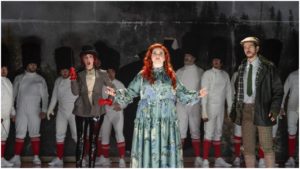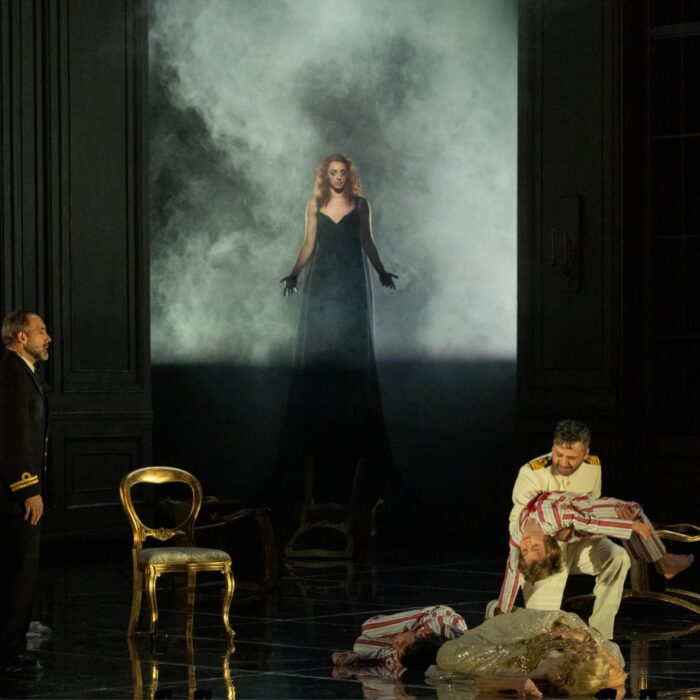
Irish National Opera 2021-22 Review: Maria Stuarda
Erraught Leads In A Beautifully Sung Production
By Alan Neilson(Photo: Pat Redmond)
Irish National Opera continues to march forward. Although only in its fifth year, it has managed to establish itself as an innovative, forward-thinking company of high quality, which successfully mixes traditional productions with new works and modern presentation methods. Whereas many companies closed down during the COVID crisis, INO used it to showcase new short operas via the internet, giving composers and singers welcome opportunities to display their talents. Their brilliantly conceived “20 Shots of Opera,” twenty operas lasting around five to six minutes, was roundly applauded and gained the company well-deserved international recognition.
Moreover, where possible INO deliberately fosters homegrown talent, providing them with opportunities for which previously they would have had to look abroad. And such is the quality of singers emerging from Ireland at this moment in time that it was able to cast both of the major roles in its current production of Donizetti’s “Maria Stuarda” with Irish singers. The well-established mezzo-soprano Tara Erraught was parted as Maria, while sopranos Ann Devin and Amy Ní Fhearraigh shared the role of Queen Elisabetta. For this review, the role was performed by Ní Fhearraigh.
Successful Presentation Overcomes Unconvincing Reading
The production, under the direction of Tom Creed, was updated to the present day on the grounds that as a matter of historical fact the two queens actually never met in person, stating “It gives license to a new production of the opera to continue to speculate. What if the events depicted were unfolding now rather than four centuries ago? How might we map the historical events onto the current state of affairs between England and Scotland? What might we learn from current news about imperial states encroaching on their smaller neighbors, where geopolitics are clouded by emotional whims?” Heavy stuff indeed, some may say overly ambitious.
And that is exactly how it turned out to be. Trying to map on a 19th-century fictional version of 16th-century history onto the political realities of the 21st century, while remaining within the straightjacket of Bardari’s libretto was doomed to failure. The underlying differences are irreconcilable, not least by the fact that the two countries are now a single political entity accepted by the people via a referendum, in which the emotional love interests of two individual leaders count for little, not to mention that even the threat of executing a rival after illegally imprisoning them is a non-starter.
What we were left with, therefore, was superficial gestures and bland tokenism, such as in the final scene when Maria strides off the stage to be executed with the Scottish flag draped over her shoulders.
Nevertheless, the updating in itself was not without merit. The use of an ankle bracelet to track Maria, a mobile phone to show Maria a photo of Leicester, and the use of a press conference for Elisabetta to address the population on her proposed marriage to the heir to the throne of France were nice touches. Where Creed really did succeed, however, was in his development of and the interaction between the characters, which were expertly rendered to bring out the full impact of the drama. Even Katie Davenport’s bare unimaginative sets, which amounted to little more than a bare stage for most of the opera, did little to reduce the intensity which Creed managed to develop, and although they were undeniably visually drab, they did open up the space for characters.
Davenports’s costume designs, however, were excellent. They were colorful, imaginative, and even humorous on occasions, yet they never undermined the unfolding tragedy, except maybe for the Queen’s guard who appeared to be dressed in white baby clothes. Elisabetta’s red, white and blue outfit, on the other hand, which looked very similar to the Union Jack was appropriately amusing, especially given the very recent Jubilee celebrations in the UK.
On the musical side, the Irish National Opera Orchestra under the baton of its artistic director Fergus Sheil produced a free-flowing rendition, full of life and rhythmic vitality, although it did not always fully exploit the darker aspects of the score. Sheil also elicited excellent performances from the cast, whose singing was nicely balanced with the sound of the orchestra.
Erraught’s Captivating Vocal Beauty
We first meet Maria in a dreamscape with snowy tree-covered hills. It is a place of peace and tranquility, a reflection of her time spent in France, to which she gives voice in the cavatina “Oh nube! che lieve per l’aria ti aggiri,” before being rudely disturbed by Leicester who bursts in, smashing a hole through the scenery, with the news of Elisabetta’s arrival, to which she responds with the cabaletta “Nella pace del mesto reposo.” The aria immediately drew attention to Erraught’s striking vocal beauty and secure technique, which she seemingly employed without any effort whatsoever, crafting complex vocal lines, rich in detail and meaning. It all appeared so natural. There was no stress or anxiety in the voice at all. Whether in mournful, slow passages or rapid, colorfully explosive sections the beauty of the voice always shone through, and yet never at the expense of characterization. It must be said, however, that her overall portrayal of Maria suffered somewhat from her acting, which was noticeably less animated than one would expect, lacking the necessary depth and nuance, and thus did not fully convince. However, such was the quality of her vocal portrait it mattered little, she conveys so much through her voice.
Ní Fhearraigh’s Elisabetta was a splendidly drawn character. She was aggressive, regal, jealous, and easily provoked, but there was always an underlying sense of irony, magnified by her costumes, which emphasized the fact that Elisabetta was always aware she was playing a role. In her first meeting with Maria, her horse riding attire with its black leather latex trousers, red leather gloves, and whip were very much suggestive of a dominatrix, which Ní Fhearaigh successfully played up to the full, yet without ever crossing over into farce. Her gestures and bold facial expressions were wonderfully managed, and the power relationships she established with the other characters were convincing. Likewise, she produced an equally impressive singing performance. Recitatives were confidently and clearly articulated, with well-placed emotional accents and flashes of color, which successfully fleshed out her character. She attacked her arias and the ensemble scenes with real energy, making full use of her versatile and powerful voice which soared effortlessly above the orchestra and chorus, in what were convincing and expressively fine performances.
While both Erraught and Ní Fhearraigh sang exceptionally well, the confrontation between the two queens at the end of Act one, which is so often the highlight of the opera, failed to attain the stratospheric heights achieved in the best productions. While they undoubtedly captured the hostility they felt for each other, the rage which threatens to turn into a physical confrontation as their self-control dissolves and the sparks start to fly was not fully exploited. It was not the scene that automatically springs to mind when reflecting on this production, as good as it was.
Strong Supporting Cast
The tenor Arthur Espiritu was a suitably ardent Leicester. His voice has a sweet timbre and he sings with a lilting Italianate intonation, ideal for the bel canto repertoire, which his aria “Ah! Rimiro il bel sembiante” beautifully confirmed, by highlighting his natural lyricism. He performed exceptionally well in the numerous interactive recitative passages and ensembles with Erraught, Ní Fhearraigh, and Thorpe in the role of Lord Talbot, with whom his voice blended particularly well.
Bass Callum Thorpe possesses a substantial, well-supported voice with an alluring timbre, into which he is able to inject pleasing subtleties, which he used with intelligence to add depth to the role.
Lord Cecil, always eager for Mary’s execution, was played by baritone Giorgio Caoduro. Producing a well-sung performance, he created a strong picture of Elisabetta’s advisor, eager for Maria’s execution.
Mezzo-soprano Gemma Ní Bhriain was cast in the relatively small role of Anne Kennedy, a task she made the most of with a well-sung and clearly defined performance.
The Irish National Opera Chorus, under the direction of Elaine Kelly, was in superb voice throughout the evening. Although it plays a number of roles with plenty of singing opportunities, it was its sensitive and poignant accompaniment to Maria’s prayer “Deh! Tu di umile preghiera,” which brilliantly captured the tragedy of her fate, that really stood out. Its role was enhanced through the use of colorful costuming and excellent choreography, along with the energy it brought to the performance.
Overall, this was a hugely enjoyable evening. Yes, there were small areas in which improvements could have been made, not least in the director’s underlying intellectual approach to the work, which fortunately did not impact significantly on the actual staging; his fine theatrical sensitivities were obviously too strong to succumb. Ultimately, however, it was the quality of the singers that will be remembered, and not just Erraught and Ní Fhearraigh, everyone, including the chorus, played their part superbly.



